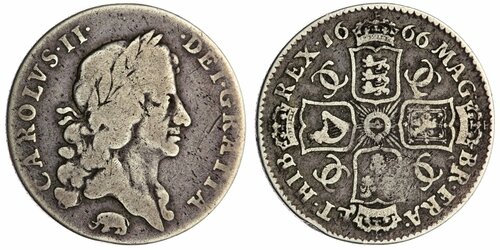
Auction: 22107 - Spink Numismatic e-Circular 17: Part I - A Gentleman's Collection of Crowns, Halfcrowns and Florins - e-Auction
Lot: 959
Charles II (1660-85), Shilling, 1666, laureate bust right, 'Guinea head', elephant below, rev. four crowned shields cruciform, five strings to harp, milled edge, 5.95g, 6h (Bull 509-R4; ESC 1027; S.3374), fine, a great rarity and very difficult to find in better condition
ESC notes the theory that the Shilling dies might have been 'lost in the Great Fire' and so this Guinea die 'had to be used.' This is an attractive theory, but entirely fanciful and without documentary evidence. Also, the theory has too many problems. Firstly there is the question of the punctuation. Here we have a stop before DEI, something which never featured on the Guinea, but was usual for the Shilling. How was it that a Guinea die, with this stop, was 'available' for use when no such Guineas are known? Clearly this is a die created for a Shilling, not a Guinea. Secondly there is the question of the urgency to supply Shillings. It would seem that the supply of Shillings was not great at any time in 1666, since the regular Shillings of this date, both first bust and second bust types, are very rare. There was clearly no pressing demand for Shillings either in the six months before the Fire, nor in the six months after it. and so certainly no urgent need for the Mint to quickly produce any immediately after the Fire. This is borne out by the fact that no Shillings were produced in 1667. Finally there is the practical consideration that the Mint was of course securely lodged in the Tower, and while the Great Fire did reach the streets around the Tower, it was halted before it reached the Tower itself and so the Mint was not damaged or in any way affected. A general reorganisation and clean up of the Mint, it's buildings, official and unofficial lodgings, adjoining shops, taverns, etc had been had been undertaken in 1661 and 1662, and with great care all puncheons and dies had been siezed and secured inside the Mint. At the same time security was tightened and strictly enforced. How was it that Shilling dies (and only Shilling dies?) were destroyed in the Great Fire?
A more fruitful line of enquiry might be related to the appearance of the elephant below the bust. This is of course the Badge of the Company of Royal Adventurers (later the Royal African Company), which had for some years been supplying the Mint with gold. In 1666 the Company also supplied silver to the Mint, and accordingly, and for the first time, Halfcrowns and Shillings were struck with the elephant. The elephant puncheons were of course kept with the other punches for the gold coinage. It is less romantic than the Great Fire theory, but it is more probable that a punch for a Guinea bust was simply picked up with the punch for the elephant, and used in error.
Subject to 20% VAT on Buyer’s Premium. For more information please view Terms and Conditions for Buyers.
Estimate




